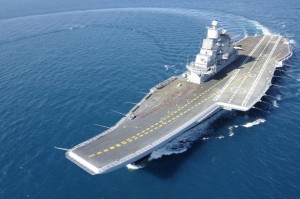China’s Aircraft Carrier Trouble: Spewing Steam and Losing Power
‘Liaoning’ shut down during recent sea trials
There’s no more of a conspicuous and potent symbol of China’s growing naval power than the aircraft carrier Liaoning.
But the 53,000-ton, 999-foot-long carrier could be dangerous to her crew and prone to engine failures. If so, that makes the vessel as much of a liability as an asset to Beijing.
The ex-Soviet carrier once went by the name Varyag until a cash-strapped Ukraine sold the ship to Beijing in 1998. The Chinese navy has since invested considerable resources into modernizing the warship and testing her at sea.
But on at least one occasion during recent sea trials, Liaoning appeared to suffer a steam explosion which temporarily knocked out the carrier’s electrical power system. The failure, reported by Chinese media site Sina.com, resulting from a leak in “the machine oven compartment to the water pipes.”
We’re only able to glimpse at the carrier’s engine problems, as we know very little about what’s inside the ship. This includes even what kind of engines Liaoning has.
The Chinese government also doesn’t like to admit to problems with its military hardware. When it does—and that’s never guaranteed—the admissions often come months or years after problems come up.
During the accident, hot water and steam began “spewing” out of the engine’s oven compartment, Sina.com reported. One cabin became “instantly submerged in water vapor,” the report added.
The crew immediately evacuated the cabin, with one officer apparently pulling a sailor out by his collar to save him from the extremely hot steam. The carrier then lost power, but the crew “eventually restored power to ensure the smooth operation of the ship.”
Fortunately, this doesn’t appear to have been a catastrophic boiler failure of the kind that would unleash almost instantaneously lethal, high-pressure steam. It’s possible Liaoning instead suffered a low-pressure steam release involving a faulty heat exchanger. Vessels commonly use heat exchangers to control water temperature necessary for regulating internal power and heating.
The Chinese navy began modernizing the ex-Varyag in 2005—essentially rebuilding the carrier from the inside. New electronics, self-defense anti-aircraft guns and new engines were just some of the upgrades. The warship in her unimproved condition was a “basket case,” an unnamed officer told the Website.
Engine failures are not an unknown phenomenon aboard ex-Soviet carriers. The 40,000-ton displacement Indian carrier Vikramaditya—first a Soviet Kiev-class carrier commissioned in 1987 and sold in 2004—temporarily shut down at sea after a boiler overheated two years ago.
The 50,000-ton Russian carrier Admiral Kuznetsov also goes nowhere without a tug escort in case her engines break down while underway.
The Chinese navy isn’t going to get rid of Liaoning any time soon. She’s Beijing’s first serviceable carrier and the ship is a valuable resource for naval flight operations. Even if China never sends her into battle, she’s useful for training and learning how carriers work.
But powerplant problems can also make it so China can do little else. Failures can add costly repairs, shorten the vessel’s lifespan and force her to crawl along the water at slow speeds. Beijing also lacks large overseas naval bases—a necessity if trouble arises while Liaoning sails far from China’s shores.
If she ever does. Liaoning is more alike to its ex-Soviet cousins than different—confined to home ports and restricted from challenging rivals like India.
“Since China began to send navy convoys on anti-piracy missions to the Gulf of Aden and the Somali coast in 2008,” military analyst Liu Zhongmin wrote in Global Times in 2010. “The lack of overseas bases has emerged as a major impediment to the Chinese navy’s cruising efficiency.”
Now add the possibility of engine problems.
Back to Top
